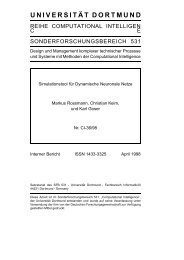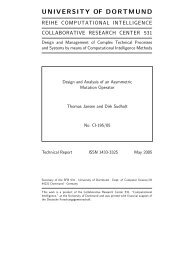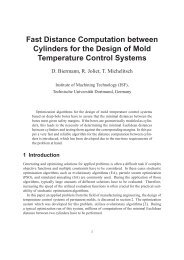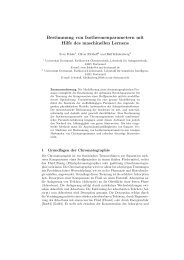Self-Adaptive Genetic Algorithms with Simulated Binary Crossover
Self-Adaptive Genetic Algorithms with Simulated Binary Crossover
Self-Adaptive Genetic Algorithms with Simulated Binary Crossover
You also want an ePaper? Increase the reach of your titles
YUMPU automatically turns print PDFs into web optimized ePapers that Google loves.
help us to create problem specific crossover operators, if needed. The evidence of self-adaptive behavior<br />
of real-parameter GAs <strong>with</strong> SBX operator in this study suggests that, besides the properties mentioned in<br />
Section 2, the following are also important properties that a self-adaptive real-parameter GA should have<br />
in their search operator:<br />
The crossover operator must produce children population which has the same mean as that in the<br />
parent population.<br />
The variance of the resulting children population may be larger than that of the parent population.<br />
The first property distinguishes the crossover operator from the selection operator. The primary task of a<br />
crossover operator is to search the region represented by the parent solutions. There is no reason why a<br />
crossover operator should have any bias towards any particular region in the search space. It is precisely<br />
the task of the selection operator to guide the search towards better regions in the search space. The<br />
second property helps to maintain a balance between the spread of solutions under selection and crossover<br />
operators. Since selection emphasizes good solutions by eliminating bad solutions in a population, it may,<br />
in general, reduce the variance of the population. If the crossover operator also has a tendency to reduce<br />
the variance of the population, the overall search algorithm may not have adequate power to adapt to any<br />
function landscape. Thus, it may be desirable to have a crossover operator which, in general, increases the<br />
variance of the parent population.<br />
In self-adaptive ES studies, it has been observed that using multi-parent crossovers provides better local<br />
convergence properties. In this study, we have only confined crossovers having two parents. However, a<br />
suitable extension to the SBX operator <strong>with</strong> more than two parents may lead to an algorithm <strong>with</strong> a faster<br />
progress rate. In the following, we outline one such possible algorithm. It has been discussed earlier that<br />
in the SBX operator the variance of children distribution depends on the distance between the two parents.<br />
It is also important to use a distribution which assigns more probability for creating near-parent solutions<br />
than solutions away from the parents. It may not be of significant importance what distribution is actually<br />
used—whether the polynomial distribution used in this study or any other distribution <strong>with</strong> the above<br />
property. In order to be closer <strong>with</strong> mutation operators used in ES studies, a normal distribution <strong>with</strong> zeromean<br />
and a standard deviation proportional to the distance between two parents can be used, instead of the<br />
polynomial distribution. In such a scheme, a parent is first identified. A second parent is randomly chosen<br />
to compute the distance (either variable-by-variable or vector-wise) between both parents. Thereafter,<br />
a child is created <strong>with</strong> a normal distribution having its mean at the first parent and standard deviation<br />
proportional to the distance. In principle, such a crossover operator (it will still be a crossover operator,<br />
because more than one parents will be used to create a child solution) should also have the self-adaptive<br />
power. Once such a principle is established, a multi-parent (more than two parents) crossover can be<br />
designed. The distance measure used to define the standard deviation for the normal distribution can be<br />
computed as a weighted sum of the distances multiple parents have from the parent being mutated.<br />
In solving the correlated functions and generalized ridge functions, it is observed that progress towards<br />
the optimum is linear, instead of exponential, to the generation number. One way to speed up the progress<br />
would be to use a correlated SBX operator which exploits the pair-wise interactions among variables. One<br />
such procedure would be to first use variable-by-variable SBX crossover. Thereafter, the resulting children<br />
solutions can be modified further by performing a line SBX operator on pairs of variables. In a line SBX<br />
operator, children solutions are found along the line joining the two parents. Such a pair-wise crossover<br />
for variables can allow progress of solutions in directions where correlated interactions exist.<br />
The primary reason for emphasizing the research in real-parameter optimizations using evolutionary<br />
optimization techniques is their use in real-world search and optimization problems of science and engineering.<br />
With the indication of self-adaptive behavior of real-parameter GAs in this study, such GAs can<br />
be tried to solve real-world search and optimization problems, where self-adaptation is an essential feature<br />
needed in an algorithm to solve a problem.<br />
In this connection, it is important to note that there exists no study identifying properties that a search<br />
and optimization algorithm should have in order for it to be qualified as a self-adaptive algorithm. Research<br />
21








